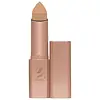What's inside
What's inside
 Key Ingredients
Key Ingredients

 Benefits
Benefits

 Concerns
Concerns

 Ingredients Side-by-side
Ingredients Side-by-side

Dimethicone
EmollientTrimethylsiloxysilicate
EmollientCaprylyl Methicone
Skin ConditioningOctyldodecanol
EmollientSynthetic Wax
AbrasiveLauroyl Lysine
Skin ConditioningPhenylpropyldimethylsiloxysilicate
EmollientDiisostearyl Malate
EmollientDicalcium Phosphate
AbrasivePolyethylene
AbrasiveCopernicia Cerifera Wax
Stearyl Heptanoate
EmollientDisteardimonium Hectorite
StabilisingStearyl Caprylate
EmollientPentaerythrityl Tetra-Di-T-Butyl Hydroxyhydrocinnamate
AntioxidantPropylene Carbonate
SolventPolyhydroxystearic Acid
EmulsifyingCaprylic/Capric Triglyceride
MaskingIsostearic Acid
CleansingLecithin
EmollientPolyglyceryl-3 Polyricinoleate
EmulsifyingBlue 1 Lake
Cosmetic ColorantIron Oxides
CI 15850
Cosmetic ColorantCI 77891
Cosmetic ColorantDimethicone, Trimethylsiloxysilicate, Caprylyl Methicone, Octyldodecanol, Synthetic Wax, Lauroyl Lysine, Phenylpropyldimethylsiloxysilicate, Diisostearyl Malate, Dicalcium Phosphate, Polyethylene, Copernicia Cerifera Wax, Stearyl Heptanoate, Disteardimonium Hectorite, Stearyl Caprylate, Pentaerythrityl Tetra-Di-T-Butyl Hydroxyhydrocinnamate, Propylene Carbonate, Polyhydroxystearic Acid, Caprylic/Capric Triglyceride, Isostearic Acid, Lecithin, Polyglyceryl-3 Polyricinoleate, Blue 1 Lake, Iron Oxides, CI 15850, CI 77891
Octyldodecyl Myristate
EmollientIsononyl Isononanoate
EmollientPentaerythrityl Tetraisostearate
EmollientSynthetic Wax
AbrasiveDiisostearyl Malate
EmollientSynthetic Fluorphlogopite
Silica
AbrasiveBis-Diglyceryl Polyacyladipate-2
EmollientDiisostearoyl Polyglyceryl-3 Dimer Dilinoleate
EmollientCaprylic/Capric Glycerides
EmollientCaprylic/Capric Triglyceride
MaskingSorbitan Isostearate
EmulsifyingMicrocrystalline Wax
Emulsion StabilisingEthylene/Propylene Copolymer
AbrasivePolyglyceryl-2 Triisostearate
EmulsifyingLecithin
EmollientMethicone
EmollientTriethoxycaprylylsilane
Aluminum Hydroxide
EmollientWater
Skin ConditioningBHT
AntioxidantTitanium Dioxide
Cosmetic ColorantCI 77492
Cosmetic ColorantCI 77491
Cosmetic ColorantCI 77499
Cosmetic ColorantOctyldodecyl Myristate, Isononyl Isononanoate, Pentaerythrityl Tetraisostearate, Synthetic Wax, Diisostearyl Malate, Synthetic Fluorphlogopite, Silica, Bis-Diglyceryl Polyacyladipate-2, Diisostearoyl Polyglyceryl-3 Dimer Dilinoleate, Caprylic/Capric Glycerides, Caprylic/Capric Triglyceride, Sorbitan Isostearate, Microcrystalline Wax, Ethylene/Propylene Copolymer, Polyglyceryl-2 Triisostearate, Lecithin, Methicone, Triethoxycaprylylsilane, Aluminum Hydroxide, Water, BHT, Titanium Dioxide, CI 77492, CI 77491, CI 77499
 Reviews
Reviews

Ingredients Explained
These ingredients are found in both products.
Ingredients higher up in an ingredient list are typically present in a larger amount.
This ingredient is an emollient, solvent, and texture enhancer. It is considered a skin-softener by helping the skin prevent moisture loss.
It helps thicken a product's formula and makes it easier to spread by dissolving clumping compounds.
Caprylic Triglyceride is made by combining glycerin with coconut oil, forming a clear liquid.
While there is an assumption Caprylic Triglyceride can clog pores due to it being derived from coconut oil, there is no research supporting this.
Learn more about Caprylic/Capric TriglycerideDiisostearyl Malate is an emollient and most often used in lip products. It comes from isostearyl alcohol, a fatty acid, and malic acid, an AHA.
As an emollient, Diisostearyl Malate helps create a thin film on your skin to trap moisture in. This helps keep your skin soft and smooth.
Lecithin is a term for a group of substances found in the cell membranes of plants, animals, and humans. They are made up of mixture of phospholipids.
This ingredient has emollient and emulsifying properties.
As an emollient, lecithen helps soften the skin and creates a barrier to keep moisture in.
As an emulsifier, it also helps prevent water and oil ingredients from separating. Lecithin can also help ingredients be better absorbed by the skin.
This is because the phospholipids in lecithin produce liposomes. Liposomes help other ingredients get through the skin barrier.
Depending on the source of this ingredient, lecithin may not be fungal acne safe. This is because some sources of lecithin come from soybean oil, which may feed the malassezia yeast that feeds fungal acne.
We recommend reaching out to the brand you are purchasing from to inquire about the source of their lecithin.
Some other names for this ingredient include soy lecithin and deoiled soy lecithin.
Learn more about LecithinSynthetic Wax is created from fossil fuels such as natural gas. It is used to enhance texture, adjust pH, and as an occlusive.
It may also be used as an abrasive ingredient to exfoliate the skin.
Synthetic Wax may not be fungal acne safe.
Learn more about Synthetic Wax